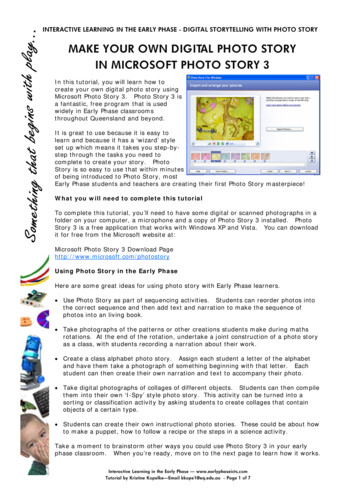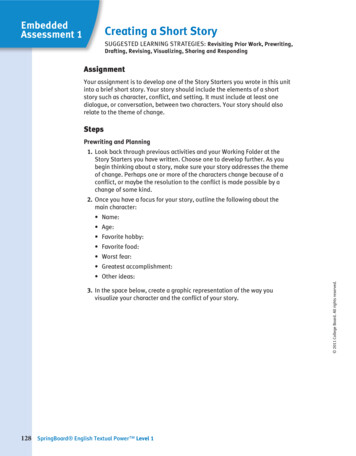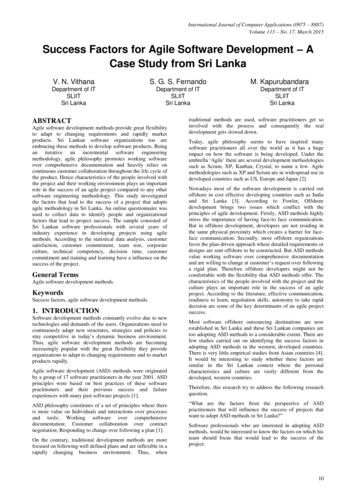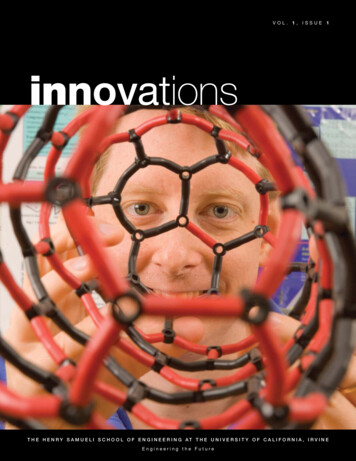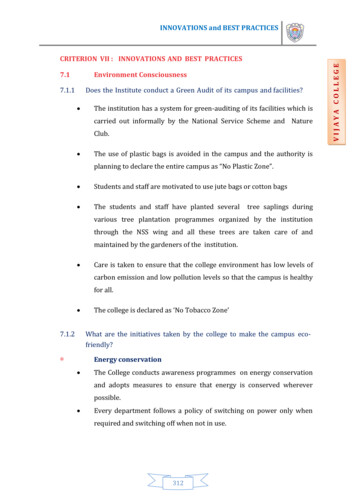
Transcription
CUSTOMER SUCCESS STORYAutoverification for HematologyFor Santa Clara Valley Medical Center’s Laboratory Hematology Department, aninvestment in new hematology analyzers and a laboratory information systemwas just the beginning. After adding autoverification with Data Innovations Instrument Manager , the laboratory increased value to its patients byautomating a manual, time-consuming, and resource-intensive process.“Autoverification is the best thing that has ever happenedto us - especially for routine tests,”- Helen Ferrer, Hematology SupervisorDoc ID: DATAINN-728876664-798 I Version 4.0
Facts at a GlanceSanta Clara ValleyMedical Center Public health hospital withnearly 500 beds Serving Santa Clara County,California, for more than140 years Trauma Center, BurnCenter, HematologyOncology Clinic Children’s Health, Women’sHealth, Diabetes Care,Rehabilitation Services 600-bed acute care facilitySanta Clara ValleyMedical CenterLaboratory HematologyDepartment Performs 88,000 monthlytests including 18,000 inhematology Epic Beaker LaboratoryInformation System Sysmex XN-3000hematology analyzer, SP-10automated slide maker /stainer, and CellaVisionDM1200 image analysis Data InnovationsInstrument Managermiddleware for hematologyautoverificationAbout Santa Clara Valley Medical Center & LaboratoryHematology DepartmentSanta Clara Valley Medical Center (SCVMC), located in San Jose, California,has served Santa Clara County patients for more than 140 years. With nearly500 inpatient beds, SCVMC includes trauma and burn centers as well as acomprehensive hematology-oncology clinic. The centers of excellence also offerspecialized care for children, women, diabetes and patient rehabilitation.SCVMC Clinical and Anatomic Pathology Laboratory performs more than onemillion tests annually. In addition to inpatient diagnostic services, it is also a keyreference laboratory for outpatient clinics and community hospitals throughoutnorthern California.The SCVMC Laboratory Hematology Department, staffed by 30 employees,performs more than 18,000 CBCs with hemogram tests monthly on Sysmex XN-3000 , Sysmex SP-10 automated slide maker/stainer and CellaVision DM1200 digital morphology analyzers. Analyzers connect with Epic Beaker laboratory information system using Data Innovations’ Instrument Manager system.Key Challenges: Manual Processes, Resource Limitations, TestTurn-around TimeFollowing the purchase of hematology analyzers and the implementationof Beaker, the timing was appropriate to turbocharge workflow productivitythrough the introduction of autoverification. Autoverification augmentsmedical technologist efficiency by using user-defined, rules-based logic to verifylaboratory test results with precision, accuracy, and consistency.Challenges were:Manual Processes: Before autoverification, medical technologists usedinstrument result printouts to confirm information in the LIS. This requiredmanual analysis and approval of hundreds-of-thousands of results every yearas well as a dependency on paper.“One-by-one, 100% of our hematology tests were manually verified and whatwe wanted to do was focus on the positives. Those are the ones that neededattention,” said Helen Ferrer, Hematology Supervisor.Staff Coverage Limitations: Like organizations worldwide in the clinicallaboratory industry, the SCVMC Laboratory Hematology Department has feltthe impact of a staffing shortage particularly during heavy workload periods,lunch hours, and off-shifts.Routine Specimen Turnaround Time (Routine TAT): Manual analysis andverification consumed disproportionate amounts of key staff time, causinga delay in routine diagnosis and potentially lengthier hospital stays. TATwas not meeting standards even with department leadership working thebench during peak volumes and taking time away from their administrativeresponsibilities.Something had to change and it did.Solution: Autoverification with Data Innovations’ InstrumentManagerAs part of a research effort, the Hematology Department turned to casestudies and peer-reviewed papers to better understand the process towardsautoverification and potential outcomes.During this vetting process, several alternatives were explored includingsolutions provided by the hematology analyzer vendors. The HematologyDepartment ultimately selected Instrument Manager (IM) for these primaryreasons: Robust autoverification functionality (compared to others considered);Doc ID: DATAINN-728876664-798 I Version 4.01
The possibility of adapting rules to the laboratory’sSimulated technologist review workstations were setup about one month before go-live which gave thetechnologists a chance to practice the new workflowbefore handling live patient results.unique workflow and not the other way around.Instrument Manager, for more than 25 years, has beenempowering laboratories worldwide to adapt to majorforces impacting healthcare.Also, SCVMC super users attended classes at the trainingcenter in South Burlington, Vermont. Learning contentincluded basic operations, instrument identificationmapping, system troubleshooting, design, creation andvalidation of rules, among other topics.When asked about what makes IM different, DIcustomers often comment about its robust and flexiblerules engine, which is used to overcome the mostchallenging workflows in thousands of laboratoriesworldwide. The rules engine provides hundreds ofpatient, specimen, and test data elements and actionsthat can be used in various permutations to handle themost complex decisions for autoverification. The systemis designed so you can develop and deploy rules fortoday’s challenges and evolve as your laboratory needschange.“We wanted them to feel comfortable in this newenvironment because it is completely differentfrom what they were used to.”- Linda Nguyen, Assistant Hematology SupervisorThe team set the following goals for hematologyautoverification:On the connectivity side, DI partners with instrumentsuppliers and LIS software companies, includingEpic, to develop drivers with intelligent and dynamicintegration that help laboratories adapt to and mitigatethe impact of change, such as instrument and LISreplacements, laboratory expansions, consolidation, andstandardization initiatives. Customize autoverification rules based on the DIanalysis of the Hematology Department workflow; Standardize work processes for technologists tofollow; Standardization of results (information) productionBut what did all this mean for the HematologyDepartment?across organization regardless of instrument or LISvendor;Implementation: Getting Started with Auto verif ication at SCVMC Obtain laboratory management approval on flaggingAn interactive process involving DI experts and thelaboratory team commenced. First, a DI laboratorysolution consultant (DI consultant) visited the laboratorythree times. The purpose was to observe the lab’sworkflow and to discuss desired outcomes andrequirements to achieve hematology autoverification. Establish a process to rapidly disable autoverification,limits on the XN-3000;if necessary.Soon after go-live, the benefits of IM hematologyautoverification became clear.Results: Customized Rules, Accurate Auto verification, 83% Tests Autoverified, Labo ratory EfficiencySCVMC Laboratory Hematology Department staffand the DI consultant reviewed instrument capability,processes, LIS requirements, and more. They notedSTAT and routine test workflow; smear review andreflex testing criteria, and handling of digital instrumentimages, among other areas.Instrument Manager operating in conjunction withSysmex and CellaVision instruments and Epic BeakerLIS, made possible these outcomes for the HematologyDepartment:Utilizing Santa Clara’s requirements and extensiveexperience, a DI consultant designed customized rulesets and tailored user screens for their specific workflowrequirements and industry best practices. The rulesets included automated hold and release criteria fortechnologists’ evaluation of blood smears with slideimages. Based on the laboratory’s standard operatingprocedures (SOPs), specific workflow instructions onhandling each of many abnormal scenarios were alsocreated and displayed to the technologist at the time ofreview to standardize outcomes and efficiency.Custom rule set: It’s a new world for test verification dueto these robust rules, created by DI especially for SCVMCLaboratory Hematology Department:Results flagging and smear: In this impactful rule,IM criteria recognizes that a blood smear review isnecessary based on specific results and/or flags.Then, a slide is made on the SP-10 automated slidemaker for examination by technologists.Platelet count fluorescent (PLT-F) reflex and resulting: Therule set leverages the laboratory’s new technologyusing PLT-F technology.Delta checking: The comparison of previous valueswithin a specific time horizon becomes especiallyimportant to variouscombinations of plateletresults.“Our workflow is very, very special. DI recognizedthat and identified our needs and customized therules for our laboratory.”- Helen Ferrer, Hematology Supervisor2Doc ID: DATAINN-728876664-798 I Version 4.0
Nucleated red blood cells (NRBCs) calculation: Thelaboratory’s proficiency in performing 100 celldifferential is enabled by IM.Resources are in harmony with workload: Now, staffingper shift is adequate since the Hematology team isempowered with autoverification. This has significantlyreduced overtime.Pathology review: Implement specific and automaticsecondary review by a pathologist with a date andtime stamp.Paperless workplace emerges: Through elimination ofthe manual processes, IM middleware made possible anew paperless hematology workflow. Now, there areminimal, if any, printouts and fewer results to manuallyrelease.Accurate autoverification: IM draws attention toabnormal results requiring technologists’ reviewand enables normal results, which staff previouslyand tediously reviewed using paper, to be madeimmediately available to providers.Staff satisfaction increases as stress is reduced: The newautomated workflow has alleviated workplace pressureand made way for new assignments. After technologistsload specimens on the analyzer, other challengingduties are pursued. They pick up positive results, heldby IM, addressing STATs and critical results immediately.“Our technologists can focus on the trueabnormals and other non-automated tests.”Custom screens and standards guide the laboratoryteam: Now, computer screens guide technologists inabnormal result decisions. DI’s user-friendly technologymakes it possible for them to view custom screensdisplaying SCVMC-specific color coding (for example,red stands for critical results, and green for resultsalready reviewed and released, to name just a coupleof examples). Specific work SOP-driven instructionsare included with all abnormal results. This gives eventhe least experienced technologists confidence thatabnormal results are being appropriately handled. Priorto launch of IM, steps taken on abnormal results mayhave differed by individuals and shifts.“Our technologists are less stressed. They don’t feelintimidated when they come in the laboratory andsee racks of specimens - especially on the PM shiftor after the morning (patient) draws. They knowmost of them are going to be autoverified.”Leadership focused on quality: Leaders concentrateon strategic responsibilities such as quality assurance,technology evaluation, and new business opportunities.They no longer need to backfill bench workflow.The results compelled the Hematology Department todo even more with IM.“Now, they have instructions about what they definitelyneed to do and everyone is doing the same thing,”Helen said.Empowered SCVMC Laboratory Team TakesNext Steps, Plans for More Autoverificationwith DIAchieved 83% autoverification rate: We now autoverify83% (or about 15,000) of hematology tests eachmonth. About 3,000 monthly tests (i.e. “abnormals”)are manually verified. Prior to implementing IM,100% of hematology tests were manually verified byseveral technologists. As time goes on, the rules canbe enhanced by the designated user(s) to continue toincrease that level of autoverification.Through its implementation philosophy and continuingeducation (webinars, regional and onsite training) and24-7-365 critical support, DI empowers customers toindependently maintain and expand autoverification.Since the hematology autoverification project went live,Hematology super users autonomously changed Deltaranges; added rules to accommodate retic add-onscalculation and smear order for newborns (under oneyear old); and edited rules to accommodate unexpectedscenarios.“Results are readily available for physicians;especially inpatient test results. This is important toa timely discharge and we are getting less calls tothe labs and less pressure.”As for their current plans, the SCVMC Laboratory isengaging DI again for autoverification - this time forReduced TAT for negative test results: Normal testresults, not held for review, can be reported fasterto physicians. Turn-around time (TAT) for 83% ofthe patients is mere seconds where before TAT mayhave been 15 minutes to one hour—depending onavailability of the technologists. Before the launch ofautoverification, TAT for normal CBCs was 52 minutes,which included manual reviews. With autoverification,TAT for normal CBCs fell to 28 minutes; an incredible46% improvement!Left to right: Yanu Yang, Marizza Nobida, Joanna Santos, Mark Payne (LIS),Tina Garcia (LIS), Dat Bui, Linda Nguyen, Helen Ferrer, Kristina Garma (LIS)Doc ID: DATAINN-728876664-798 I Version 4.03
its Roche Diagnostics chemistry analyzers and forcoagulation instruments.Santa Clara leaders, enthused about their work withDI, are quick to advise their hospital colleagues,contemplating autoverification, to: Visit a laboratory and observe its autoverificationtechnology; Have a firm grasp on the laboratory’s day-to-dayworkflow as well as the unique and specific scenariosthat need to be sufficiently accommodated by therule set;Test and simulate new autoverification processesbefore launch.“Test, test, test. Give your staff adequate time fortraining. Have them run through and practice usingthe system. Autoverification is the best thing thathas ever happened to us - especially for routinetests.”- Kristina Garma, CLS, LISBeaker is a registered trademark of Epic Systems Corporation.Sysmex is registered service mark of Sysmex Corporation (Japan)XN-3000 and SP-10 are registered trademarks of the Sysmex Corporation.CellaVision is a registered service mark of the CellaVision AB Corporation (Sweden)Roche is a trademark of Hoffmann - LaRocheAbout Data InnovationsFounded in 1989, Data Innovations (DI) is the world’s largest and most successful clinical and blood laboratorymiddleware company. With a focus solely on laboratory data management, DI offers the most complete middlewaresystem in the market to manage laboratory operations—including pre-analytical, analytical, and post-analyticalsample processing, and on-clinical tasks such as equipment maintenance and specimen archiving.LocationsNorth America120 Kimball AvenueSuite 100S. Burlington, VT 05403Europe34 av. Jacques Brel1200 Brussels, BelgiumLatin AmericaRua Cotoxó, 303 Cj 71Perdizes Tower IISão Paulo, Brasil 05021-000AsiaRoom 3709, 37/F.,118 Connaught Road WestHong KongSales: 802-264-3470Technical: 802-658-1955Sales: 32 2 332 24 13 32 2 770 62 22Technical: 32 2 332 24 13Sales: 55-11-38013283Technical: 55-11-38013283Sales: 852-2398-3182Technical: 852-2398-3182For more information, call our solution specialists at 802-264-3470or visit our website: www.datainnovations.com.
Serving Santa Clara County, California, for more than 140 years Trauma Center, Burn Center, Hematology-Oncology Clinic Children's Health, Women's Health, Diabetes Care, Rehabilitation Services 600-bed acute care facility Santa Clara Valley Medical Center Laboratory Hematology Department Performs 88,000 monthly
